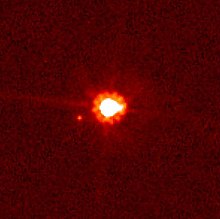
Back Eris (dwergplaneet) Afrikaans (136199) Eris AN إريس (كوكب قزم) Arabic إريس ARZ 136199 Eris AST Erida Azerbaijani (136199) Eris BAR Эрыс (карлікавая планета) Byelorussian Эрыс (карлікавая плянэта) BE-X-OLD Ерида (планета джудже) Bulgarian


Eris (symbol ![]() )[1] is a dwarf planet and a trans-Neptunian object (TNO).[2] It is the second-largest known dwarf planet in the Solar System. Eris is slightly smaller than Pluto, but it has more mass than Pluto.
)[1] is a dwarf planet and a trans-Neptunian object (TNO).[2] It is the second-largest known dwarf planet in the Solar System. Eris is slightly smaller than Pluto, but it has more mass than Pluto.
It is a "scattered disc object" in the Kuiper belt, further out than Pluto. It is also called a plutoid because the IAU decided to rename all trans-Neptunian dwarf planets as plutoids.[3] Eris orbits the sun once every 557 Earth years.[4] It has an elliptical orbit, inclined at an angle of 44° between the plane of the orbit of the planet and the ecliptic, the plane containing Earth's orbital path.[5]
Eris has one moon, called Dysnomia.
- ↑ JPL/NASA (2015-04-22). "What is a Dwarf Planet?". Jet Propulsion Laboratory. Retrieved 2022-01-19.
- ↑ Formal designation: 136199 Eris; Provisional designation: 2003 UB313.
- ↑ Lang, Kenneth R. (2011). The Cambridge Guide to the Solar System (Second ed.). Cambridge University Press. p. 442. ISBN 978-0-521-19857-8.
- ↑ Harvey, Samantha (2011-03-24). "NASA: Solar System Exploration: Planets: Dwarf Planets: Eris". NASA. Archived from the original on 2013-02-02. Retrieved 2011-03-31.
- ↑ Sicardy, B.; Ortiz, J. L.; Assafin, M.; Jehin, E.; Maury, A.; Lellouch, E.; Gil-Hutton, R.; Braga-Ribas, F.; Colas, F.; Widemann (2011). "Size, density, albedo and atmosphere limit of dwarf planet Eris from a stellar occultation" (PDF). European Planetary Science Congress Abstracts. 6: 137–138. Bibcode:2011epsc.conf..137S. Retrieved 2016-02-19.